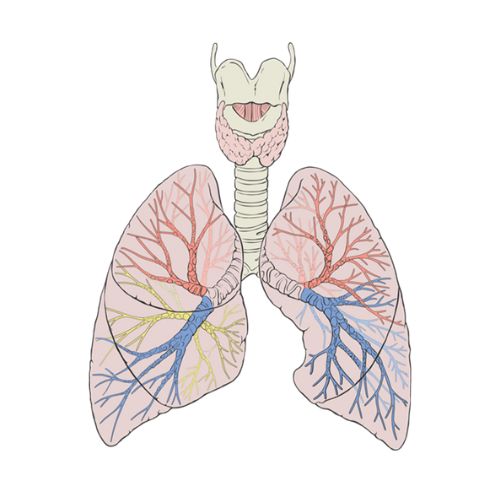Bronchial asthma is a long-term condition that affects the airways in our lungs, making them swollen and sensitive and narrow. This can cause episodic symptoms like wheezing, coughing, chest tightness, and shortness of breath. An episode of asthma can be triggered by things like exercise, allergies, cold air, or infections.
What happens in asthma?
Our lungs are made up of a main breathing tube called the trachea that divides into 2 for each lung and each main bronchial tube then divides into multiple branches until they end in an air sac called alveolus. It is somewhat like an inverted tree. For normal breathing, open bronchial tubes free of mucus is necessary. When we have an asthma attack, our airways become narrow and inflamed. This makes it harder for air to move in and out of our lungs. Sometimes, asthma symptoms are mild, but they can get worse quickly, which is called an asthma attack or exacerbation.

Asthma can be triggered by anything and everything under the sun including the sun itself for some patients. Each individual patient has their own specific set of triggers. Common triggers include pollen, grasses, trees, dust mites, exercise, cold air, pets, molds, cockroaches. Some women have periodic asthma episodes related to the menstrual cycle. It is extremely important to recognize your own asthma triggers and try to avoid them if possible.
How is asthma managed?
The main goals are to control symptoms, prevent attacks, and minimize side effects from medicines. Management includes:
1.First and foremost is avoiding known asthma triggers.
2. Taking medications as prescribed: These may include inhalers for daily control called maintenance inhalers and quick-relief inhalers for sudden symptoms called rescue inhalers. The maintenance inhalers usually contain inhaled form of steroids in combination with long-acting medications that open up bronchial tubes. The rescue inhaler is usually in the form of albuterol. It’s important to learn the correct way to use an inhaler. If you are not sure about the correct inhalation technique of your inhalers, please ask your physician.
3.Monitoring your symptoms: Keep track of how you feel and use tools like a peak flow meter if recommended.
4. Follow your Asthma Action Plan: This is a written guide made with your healthcare provider. It tells you what to do every day and how to handle worsening symptoms or attacks. An Asthma Action Plan helps you know when your asthma is under control, when it’s getting worse, and when you need emergency help. It includes instructions for adjusting your medications and when to seek medical care.
When should you seek help?
If your symptoms are getting worse and your quick-relief inhaler isn’t helping, or if you have trouble speaking, walking, or breathing, get medical help right away. Sometimes the asthma symptoms can progress rapidly and seeking help in a timely fashion can be lifesaving.
Tips for living well with asthma:
– Take your medicine even when you feel fine. Do not stop your maintenance inhalers unless recommended by your physician.
– Learn and practice the correct inhalation technique.
– Keep regular appointments with your healthcare team.
– Ask questions and talk openly about your asthma and any concerns you have.
– Make healthy lifestyle choices, like staying active and eating well.
Conclusion:
Asthma is a chronic and generally incurable condition for most adults that will require some form of management activity throughout the life. However, with proper management of asthma, most people can lead an active and healthy life, like some of the Olympic athletes.
Key organizations for asthma education and support in the United States include:
Asthma and Allergy Foundation of America (AAFA): Provides patient education, advocacy, and support resources (www.aafa.org).
Allergy & Asthma Network: Offers educational materials, support groups, and advocacy (www.aanma.org).
American Lung Association: Delivers asthma education, support programs, and helplines (www.lungusa.org).
American Academy of Allergy, Asthma, and Immunology (AAAAI): Offers patient information and educational resources (www.aaaai.org).
American College of Allergy, Asthma & Immunology (ACAAI): Provides patient education and support (www.acaai.org).
Centers for Disease Control and Prevention (CDC): Maintains a comprehensive asthma resource center (www.cdc.gov/asthma).
National Heart, Lung, and Blood Institute (NHLBI): Publishes guidelines and patient education materials (www.nhlbi.nih.gov).
Environmental Protection Agency (EPA) Asthma Community Network: Offers community resources and educational materials (www.asthmacommunitynetwork.org).
Internationally, the Global Initiative for Asthma (GINA) provides patient educational materials and links to additional asthma organizations on its website (www.ginasthma.org).
Dr Sharad Vora
Cary Pulmonary Medicine

